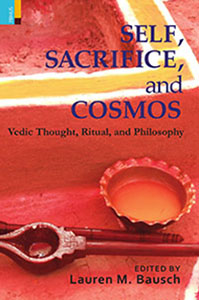
INFORMATION
- EDITOR : Lauren M. Bausch
- HB ISBN : 978-93-5290-344-3
- Year : 2019
- Extent : 260 pp.
- Discount available on checkout
- Usually dispatched within 3 to 5 working days.
Tagore
| HB ₹ 995 . $ . ₤ |
PB ₹ . $ . ₤ |
|
| POD ₹ . $ . ₤ |
e-Book ₹ . $ . ₤ |
INFORMATION
- AUTHOR –
- ISBN – 978-93-84082-78-9
- Year – 2016
- Extent: 400 + 40 coloured illustrations
- 10% discount + free shipping
- Usually dispatched within 3 to 5 working days.
The eleven articles in this volume mark a significant advance in Vedic studies. Contributions range widely across critical topics in early, middle, and late Vedic texts and their commentaries, as well as classical themes in contemporary Sanskrit literature. Essays elucidate the explanations and arguments found in Br?hmana texts, the historical and ecological development of Vedic ritual, concepts and underlying messages in Vedic texts, anachronisms in commentarial exegesis, and literary devices in narrative. From a variety of philological, philosophical, ritual, gender, and literary approaches, these articles shed new light on our understanding of these seminal texts of Indian religion and philosophy. This book is dedicated to the life and work of Professor Ganesh Umakant Thite.
The Editor
Lauren M. Bausch is Assistant Professor at Dharma Realm Buddhist University, California. A specialist in Brahmana texts and early Indian Buddhism, she is currently writing a book about the Vedic philosophy of language and causality. Bausch has contributed the following articles to important books/journals: ‘The Kanva Brahmanas and Buddhists in Kosala’; ‘Pratistha in the Brahmanas and Aranyakas’; ‘Surya Reliefs in Early Buddhist Art’; and ‘Dual Varna in Vedic Texts’.
As a global figure, Tagore transcends the boundaries of language and reaches out to people distant both in time and space. His art took inspiration from contemporary Western trends and became a powerful means to connect with people beyond Bengal. Word, image, song, and text were his tools of communication, as also his extraordinary presence in a sartorial garb of his own design. A littérateur in many genres, the impact of his work was determined both by the material he presented, and by its simultaneously local and global contexts. Now, when his international reputation has spanned over more than a hundred years, it is important to revisit the sites of Tagore’s eminence, and ask to what extent he was a ‘living text’ in the century that witnessed him as a global intellectual.
Accordingly, this volume investigates how Tagore’s writings and art are linked to the metalinguistic domains of the psychological, medical and mythical; how he was received in various cultures outside India; how his art was determined by individual circumstances and global aspirations; and how he acted as an inspiration to his contemporaries and subsequent generations including modern Indian writers and artists.
The Editor
Imre Bangha studied in Budapest and Santiniketan and at present is Associate Professor of Hindi at the University of Oxford. He has published books and essays in English, Hindi, and Hungarian on literature in Brajbhasha and other forms of old Hindi and has also prepared Hungarian translations from various South Asian languages. His work on the international reception of Bengali culture includes Rabindranath Tagore: Hundred Years of Global Reception (2014, co-edited with M. Kämpchen) and Hungry Tiger: Encounter between India and Central Europe (2007).
Table of Contents
| List Of Abbreviations | Vii-Viii |
| Editor’s Note | Ix-X |
| Introduction | 1-8 |
| Lauren M. Bausch Ganesh Umakant Thite: A Life | 9-22 |
| Brāhmaṇa As Commentary Timothy Lubin | 23-40 |
| The Consistency Of Vedic Argument Joanna Jurewicz | 41-55 |
| The Role Of Brahmana-Texts In The Development Of Vedic Ritual Ganesh Umakant Thite | 56-63 |
| Vedic Ritual: The Sacralization Of The Mundane And The Domestication Of The Sacred Stephanie W. Jamison | 64-80 |
| The Heavenly Sea Joel P. Brereton | 81-100 |
| Pratiṣṭhā In The Brāhmaṇas And Āraṇyakas Lauren M. Bausch | 101-126 |
| Women, Weapons, And Words: Gender And Sexuality In The R̥Gveda’s Weapons Hymn (6.75) Jarrod Whitaker | 127-144 |
| How Is A Vehicular Homicide Like The Sacrifice? Caley Charles Smith | 144-160 |
| Creating Context: Adisankaracarya’s Reading Of Three Akhyayikas Of The Chandogya Upaniṣad Robert P. Goldman | 161-181 |
| Ecology Of Ritual Innovation In Ancient India: Textual And Contextual Evidence Jan E.M. Houben | 182-210 |
| 11. Sanskrit As Personality Development: Emotion And Dialogue In The Twentieth Century Writings Of Kshama Rao Laurie L. Patton | 211-222 |
| Bibliography | 223-238 |
| Notes On The Editor And Contributors | 239-243 |
| Index | 245-250 |




